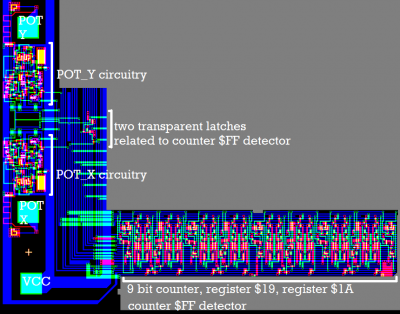Finding out what happens in which PHI2 clock cycle inside the envelope generator
can be a bit tricky, and I think I would need to gain some "mental distance"
from the schematics for making a try.

While drfiemost was busy, I tried to dig into the rest of the
SID,
and I think I should post my stuff before some of the details
start slipping from my memory...
;---
Now about the paddle related stuff:
Attachment:
 paddle.png [ 128.57 KiB | Viewed 6451 times ]
paddle.png [ 128.57 KiB | Viewed 6451 times ]
Block diagram:
Attachment:
 paddle_block.png [ 23.85 KiB | Viewed 6451 times ]
paddle_block.png [ 23.85 KiB | Viewed 6451 times ]
We have a 9 bit counter running at PHI2 speed.
Bit 7..0 from the counter are fed into two 8 bit latches, POT_X and POT_Y.
At the POT_X pin, we have an external capacitor, which is charged
through the paddle potentiometer resistance to +5V.
When the voltage at the POT_X pin has reached a certain level,
the value from the counter is loaded into the POT_X register.
Also, when the coutner has reached $FF (maybe because the paddle
potentiometer is missing), there is some circuitry that forces
loading the counter value into POT_X.
It's a 9 bit counter, while the counter MSB ( bit 8 ) is 1,
the external capacitor is discharged through a FET in the
SID which is close to the POT_X pin.
Same thing for POT_Y.
;---
So one "conversion" from paddle potentiometer position to POT_X,POT_Y value
happens within every 512 PHI2 clock cycles.
Note, that PHI2 clock frequency is different for a PAL and a NTSC C64.
If the capacitors at the POT_X, POT_Y pins in both C64s would have
exactly the same value (usualy, they haven't),
...
and if the +5V supply voltages in both C64s would be exactly the same
(usually, it isn't),
...
reading out one and the same paddle position on both C64s
probably might give you a value that differs by 4% or such.








